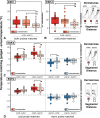Organization of the Thermal Grill Illusion by Spinal Segments
- PMID: 30063258
- PMCID: PMC6175302
- DOI: 10.1002/ana.25307
Organization of the Thermal Grill Illusion by Spinal Segments
Abstract
Objective: A common symptom of neuropathy is the misperception of heat and pain from cold stimuli. Similar cold allodynic sensations can be experimentally induced using the thermal grill illusion (TGI) in humans. It is currently unclear whether this interaction between thermosensory and nociceptive signals depends on spinal or supraspinal integration mechanisms. To address this issue, we developed a noninvasive protocol to assess thermosensory integration across spinal segments.
Methods: We leveraged anatomical knowledge regarding dermatomes and their spinal projections to investigate potential contributions of spinal integration to the TGI. We simultaneously stimulated a pair of skin locations on the arm or lower back using 1 cold (∼20°C) and 1 warm thermode (∼40°C). The 2 thermodes were always separated by a fixed physical distance on the skin, but elicited neural activity across a varying number of spinal segments, depending on which dermatomal boundaries the 2 stimuli spanned.
Results: Participants consistently overestimated the actual cold temperature on the skin during combined cold and warm stimulation, confirming the TGI effect. The TGI was present when cold and warm stimuli were delivered within the same dermatome, or across dermatomes corresponding to adjacent spinal segments. In striking contrast, no TGI effect was found when cold and warm stimuli projected to nonadjacent spinal segments.
Interpretation: These results demonstrate that the strength of the illusion is modulated by the segmental distance between cold and warm afferents. This suggests that both temperature perception and thermal-nociceptive interactions depend upon low-level convergence mechanisms operating within a single spinal segment and its immediate neighbors. Ann Neurol 2018;84:463-472.
© 2018 The Authors. Annals of Neurology published by Wiley Periodicals, Inc. on behalf of American Neurological Association.
Figures



Similar articles
-
A Review on Various Topics on the Thermal Grill Illusion.J Clin Med. 2021 Aug 16;10(16):3597. doi: 10.3390/jcm10163597. J Clin Med. 2021. PMID: 34441893 Free PMC article. Review.
-
Disentangling the spinal mechanisms of illusory heat and burning sensations in the thermal grill illusion.Pain. 2024 Oct 1;165(10):2370-2378. doi: 10.1097/j.pain.0000000000003352. Epub 2024 Aug 23. Pain. 2024. PMID: 39185673
-
Sex differences in thermal detection and thermal pain threshold and the thermal grill illusion: a psychophysical study in young volunteers.Biol Sex Differ. 2017 Sep 1;8(1):29. doi: 10.1186/s13293-017-0147-5. Biol Sex Differ. 2017. PMID: 28859684 Free PMC article.
-
Conditioned pain modulation dampens the thermal grill illusion.Eur J Pain. 2017 Oct;21(9):1591-1601. doi: 10.1002/ejp.1060. Epub 2017 Jun 2. Eur J Pain. 2017. PMID: 28573748 Clinical Trial.
-
Beyond labeled lines: A population coding account of the thermal grill illusion.Neurosci Biobehav Rev. 2020 Jan;108:472-479. doi: 10.1016/j.neubiorev.2019.11.017. Epub 2019 Nov 26. Neurosci Biobehav Rev. 2020. PMID: 31783059 Review.
Cited by
-
Using electrodermal activity to validate multilevel pain stimulation in healthy volunteers evoked by thermal grills.Am J Physiol Regul Integr Comp Physiol. 2020 Sep 1;319(3):R366-R375. doi: 10.1152/ajpregu.00102.2020. Epub 2020 Jul 29. Am J Physiol Regul Integr Comp Physiol. 2020. PMID: 32726157 Free PMC article.
-
Cortical oscillatory changes during thermal grill illusion.Neuroreport. 2023 Mar 1;34(4):205-208. doi: 10.1097/WNR.0000000000001874. Epub 2023 Jan 23. Neuroreport. 2023. PMID: 36719830 Free PMC article.
-
Thermal illusions for thermal displays: a review.Front Hum Neurosci. 2023 Dec 5;17:1278894. doi: 10.3389/fnhum.2023.1278894. eCollection 2023. Front Hum Neurosci. 2023. PMID: 38116235 Free PMC article. Review.
-
Thermonociceptive interaction: interchannel pain modulation occurs before intrachannel convergence of warmth.J Neurophysiol. 2019 May 1;121(5):1798-1808. doi: 10.1152/jn.00341.2018. Epub 2019 Mar 13. J Neurophysiol. 2019. PMID: 30864857 Free PMC article.
-
A Review on Various Topics on the Thermal Grill Illusion.J Clin Med. 2021 Aug 16;10(16):3597. doi: 10.3390/jcm10163597. J Clin Med. 2021. PMID: 34441893 Free PMC article. Review.
References
-
- Fruhstorfer H, Harju E‐L, Lindblom UF. The significance of A‐δ and C fibres for the perception of synthetic heat. Eur J Pain 2003;7:63–71. - PubMed
-
- Green BG. Synthetic heat at mild temperatures. Somatosens Mot Res 2002;19:130–138. - PubMed
-
- Adam F, Alfonsi P, Kern D, Bouhassira D. Relationships between the paradoxical painful and nonpainful sensations induced by a thermal grill. Pain 2014;155:2612–2617. - PubMed
Publication types
MeSH terms
Grants and funding
LinkOut - more resources
Full Text Sources
Other Literature Sources
Medical

